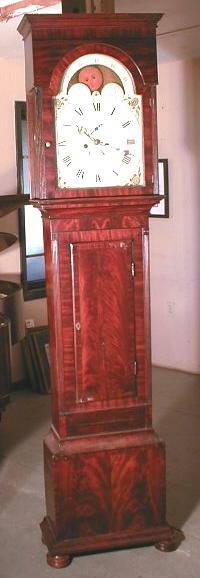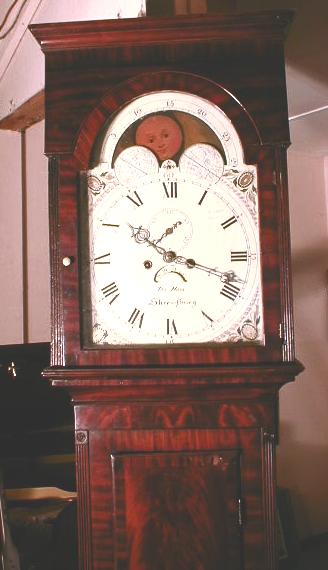
| WWT Shows | CLICK TO: Join and Support Internet Horology Club 185™ | IHC185™ Forums |

|
• Check Out Our... • • TWO Book Offer! • |
Welcome Aboard IHC185™  Internet Horology Club 185
Internet Horology Club 185  IHC185™ Discussion Site Main Page
IHC185™ Discussion Site Main Page  Horological Discussions, Questions and Answers
Horological Discussions, Questions and Answers  Clocks, Including 400-Day Discussions
Clocks, Including 400-Day Discussions  Tall Case Clock-Looks Great-Need Info/History?
Tall Case Clock-Looks Great-Need Info/History?
 Internet Horology Club 185
Internet Horology Club 185  IHC185™ Discussion Site Main Page
IHC185™ Discussion Site Main Page  Horological Discussions, Questions and Answers
Horological Discussions, Questions and Answers  Clocks, Including 400-Day Discussions
Clocks, Including 400-Day Discussions  Tall Case Clock-Looks Great-Need Info/History?
Tall Case Clock-Looks Great-Need Info/History?Go  | New Topic  | Find-Or-Search  | Notify  | Tools  | Reply to Post  |  |
Looking at this tall case clock. Could someone pass any info or history about this? Only info on it says Tho Haas with Shrewsbury under it on dial. The middle s looks like a f, it has a slash through it. He wouldn't take off face plate. Sorry for lack of info. He said he wants $1000 for it. Is that fair? Any info/advice appreciated!!!   | |||
|
Mark, most moon phase cases are finished off with broken arch hoods. I'd worry that this one had had an accident leading to broken horns and these have not been replaced properly but by the square hood seen. Only way to determine is to get that hood off. $1000 seeems cheap for a working all original moon phase. Just my 2c Peter | ||||
|
Mark, for some info on English longcase clocks, see Dennis Radage's The History of English Longcase Clocks in the John Harrison Theater section. I found it helpful when I was inquiring about longcase clocks. Norman | ||||
|
You were right very informative, thansk. | ||||
|
Could someone give a rough range of price for this clock or what price would be norm? | ||||
|
| Vienna Regulators IHC Member 313 |
Clock is from 1790 to 1810...sorry about the wide range of dates.The latter clocks had more painting in the corners. Dial fits the case nicely.Looks like a flat top is correct for this type of clockcase but still pull the bonnet for a look. Nice flame in the mahogany. Kind of in between a regency and empire style. Remember country clocks case style ran a few years behind the London style cases. Could not find the maker. Case looks nice but base has been reduced and ugly feet added.Base should be close to the size of the bonnet. Price range 1500 to 2500 so at a thousand take it and run (with those feet.... | |||
|
| Vienna Regulators IHC Member 313 |
Example of a American Chester County tall case with a movement finished in the USA using a English "kit" movement. Notice the Osbourn's iron mounting backplate. Note dial spandrels. Circa 1785. (just got case back from refinsher, walnut painted case to look like Mahogany.)Your movement and dial out very similar. | |||
|
| Vienna Regulators IHC Member 313 |
back mounting plate | |||
|
Neat clock. Need help. Looks like he wants $1500 and the clock needs work. Doesn't have pendulum and needs a good cleaning. Didn't want to spend this much. Can't get reding on face plate, even if there is something on it. Does a clock like this come around often? Should I just wait? Seems no one heard of Tho Haas. Advice appreciated, thanks! | ||||
|
I spoke with the guy and he mentioned the only writing was on the back of the moon phase dial-it read " Fenimore/Burghingham. Does this mean anything or help classify this clock and give it more value? Thanks. | ||||
|
Well an update, purchased the clock. Brought it home. Looks nice. Someone who posted was correct, there was a piece that was on the top of the clock. I see there were holes and there is glue residue on top. I have a wood person, could some direct me to some pics of what might have been on top? Also looks like there is no pendulum, does anyone have a clock like this that can foward a picture of the pendulum? Just curious ifit was relatively small or big. As always advice/help appreciated, thanks. | ||||
|
Mark, it would look something like this. http://www.merritts.com/store4/public/product.aspx?Prod...7&SubcategoryID=2033 Also could have a wood stick instead of the metal rod. Mike C. | ||||
|
Thanks, He gave a a pretty ornate bob with the clock. It was iron with painted ornate on it. Someone said that was the bob for clock, will order the suspension, though thanks! | ||||
|
Hi Mark, Please remember that the pendulum is the critical factor in dertermining the accuracy and stability of your clock! The wheels just count the oscillations of the pendulum. The stabilty of it is paramount! I would suggest you get hold of a book that shows you the theory of how the pendulum is mounted, how the crutch interfaces to the pendulum rod, how the bob fits to the rod etc. Then order or look for some stuff! This will enable you to get a pendulum installed that will do your clock justice. It is likley that your clock had a steel rod supporting a bob of about 4" diameter. The bob is probably made of lead and is covered in thin brass. At the top is a flexible strip and just below that will be a brass block that slides in the crutch.The bob will slide without shake up and down the rod under the influence of the regulating nut. If you have metal and wood skills you could with timekeeping advantage install a wooden rod, but this would not be typical for the age and type of your clock, fittings are available for this route. Will respond on the hood top later. Peter | ||||
|
Mark I have a 1800c clock made by Samuel Deacon with the arched top dial and the flat top case. I also found one other on my last trip to England with the same set up which was dated to 1790. They wanted $3,500 for that clock. The Birmingham name also indicated England as Bimingham was a major man. center for clock dials in the late 1700's and early 1800's. I don't know how much of this would also fit the English kits but I think the flat top case was more used in England than here. Bob Rancher | ||||
|
| Powered by Social Strata |
| Your request is being processed... |
|
Welcome Aboard IHC185™  Internet Horology Club 185
Internet Horology Club 185  IHC185™ Discussion Site Main Page
IHC185™ Discussion Site Main Page  Horological Discussions, Questions and Answers
Horological Discussions, Questions and Answers  Clocks, Including 400-Day Discussions
Clocks, Including 400-Day Discussions  Tall Case Clock-Looks Great-Need Info/History?
Tall Case Clock-Looks Great-Need Info/History?
 Internet Horology Club 185
Internet Horology Club 185  IHC185™ Discussion Site Main Page
IHC185™ Discussion Site Main Page  Horological Discussions, Questions and Answers
Horological Discussions, Questions and Answers  Clocks, Including 400-Day Discussions
Clocks, Including 400-Day Discussions  Tall Case Clock-Looks Great-Need Info/History?
Tall Case Clock-Looks Great-Need Info/History?©2002-2025 Internet Horology Club 185™ - Lindell V. Riddle President - All Rights Reserved Worldwide

